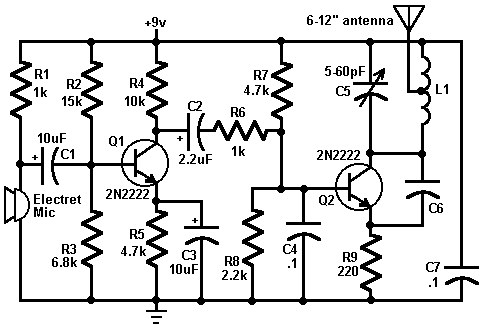
The circuit shows the FM Transmitter with power supply of 3.3 V. This in turn received by FM receivers that are tuned to pick up signal of transmitted frequency and demodulated to recover the original audio signal.įM signal is obtained by varying the carrier frequency and it has two frequencies which are message signal frequency and carrier signal frequency by that way message signal is transmitted and at receiver original signal will be obtained. This modulated signal possess enough power to be radiated aka transmitted through antenna. This powerful carrier signal is then modulated or coded using the actual audio signal by a process known as modulation ( explained here ). In a FM transmitter circuit, weak audio signals(message signals) are transmitted with the help of a carrier signal which is possess high power. Related circuit: FM spy bug circuit using transistor Components Required The circuit is powered by 3.3V battery and includes a NPN transistor, a LC tank circuit and an antenna.

This radio Transmitter transmits signal up to a range of 20m-30m. This article shows you a simple FM transmitter circuit diagram and explains in detail about its working and part selection method. These transmitter circuits may not provide long range like circuits that use dedicated FM chips but it will get the job done. If connections on the capacitor are reversed, then moving your hand near the capacitor will cause unwanted stability and oscillation.įinally here are some voltagee checks from my breadboard prototype.This should help in determining a working circuit:-Īll measurements made with a fresh 9volt battery and three BC109C transistors with respect to the battery negative terminal.Single transistor FM transmitter circuits are quite famous since it is easy to build and cost less. The moving plates should be connected to the "cold" end of the tank circuit, this is the base of Q1, and the fixed plates to the "hot end" of the coil, the juction of R1 and C1. The tuning capacitor has fixed and moving plates. This will directly drive high impedance headphones or can be fed into a suitable amplifier.Īll connections should be short, a veroboard or tagstrip layout are suitable. Audio level varies on the strength of the received station but I had typically 10-40 mV. Transistor Q3 has a dual purpose it performs demodulation of the RF carrier whilst at the same time, amplifying the audio signal. This will give adjustment of sensitivity and selectivity of the receiver. R1 could also be replaced by a fixed resisor say 33k and a preset resistor of 100k. If there is a lack of sensitivity, then try increasing R1 to around 150k. If the circuit oscillates,then R1's value may be decreased try 68k. Insufficient feedback and the receiver becomes "deaf". Too much feedback and the circuit will become unstable producing a "howling sound". The 120k resistor provides regenerative feedback,between Q2 output and the tank circuit input and its value affects the overall performance of the whole circuit. This is necessary so as not to unduly load the tank circuit.

Q1 and Q2 form a compund transistor pair featuring high gain and very high input impedance.

I used a ferrite rod and tuning capacitor from an old radio which tuned from approximately 550 - 1600kHz. The design is simple and sensitivity and selectivity of the receiver are good.Īll general purpose transistors should work in this circuit, I used three BC109C transistors in my prototype.The tuned circuit is designed for medium wave. It is similar in principle to the ZN414 radio IC which is now no longer available. This is a compact three transistor, regenerative receiver with fixed feedback.


 0 kommentar(er)
0 kommentar(er)
